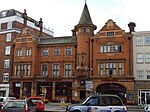Church Gate, Fulham
FulhamGrade II* listed buildings in the London Borough of Hammersmith and FulhamGrade II listed buildings in the London Borough of Hammersmith and FulhamStreets in the London Borough of Hammersmith and FulhamUse British English from November 2017

Church Gate, Fulham is a street in Fulham, London. It runs west to east, from the junction with Fulham High Street and New King's Road to the main entrance gates for the grounds of All Saints Church, Fulham. Numbers 5 and 6 are early 18th-century Grade II listed buildings.Sir William Powell's Almshouses are 12 Grade II* listed almshouses.
Excerpt from the Wikipedia article Church Gate, Fulham (License: CC BY-SA 3.0, Authors, Images).Church Gate, Fulham
Church Gate, London Parson's Green (London Borough of Hammersmith and Fulham)
Geographical coordinates (GPS) Address Nearby Places Show on map
Geographical coordinates (GPS)
| Latitude | Longitude |
|---|---|
| N 51.46931 ° | E -0.210936 ° |
Address
Church Gate
Church Gate
SW6 3LD London, Parson's Green (London Borough of Hammersmith and Fulham)
England, United Kingdom
Open on Google Maps









